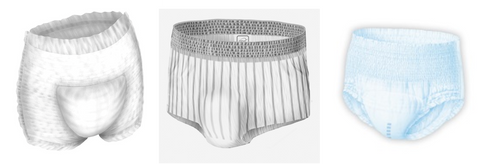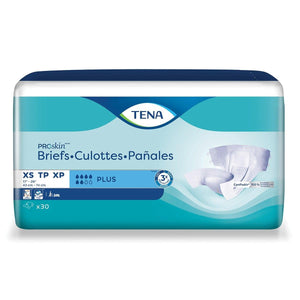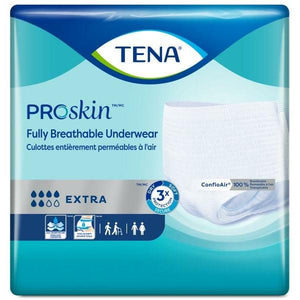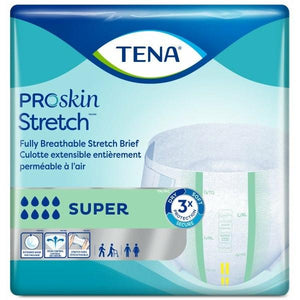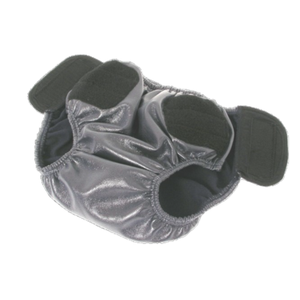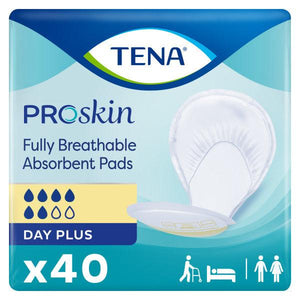A Man's Guide to Finding the Right Bladder Leak Products
Does urinary incontinence — bladder leak — have your Superhero in hiding?

I know. You’d rather go three rounds with the Joker, the Penguin or Lex Luthor than talk about urinary incontinence, right?
We get it.
Who wants to admit they have a leaky bladder? Who wants to admit they are not in control? It’s embarrassing. Undignified, even.
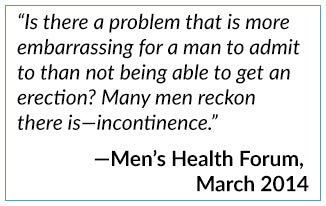
Have you found yourself turning down dinner invitations, passing on nights out with the guys or suddenly losing interest in that movie you were dying to see because of the possibility of an embarrassing “incident”? Do you miss being active and engaged with family, friends. . . and life?
If you are new to issues surrounding these issues, you may find that urinary incontinence (bladder leak) — and the decisions you've made because of it — can trigger feelings of fear, disillusionment, even anger.
“I’m 57 and have always been active—I’ve played squash as long as I remember. I recently started having these unintended leaks. I thought I’d have to stop playing completely because I was worried about embarrassing myself if I had an “accident.” It was more than frustrating—it was maddening.”
If you are a man of a certain age — which, we can tell you, is just about any age —who has recently started experiencing these minor leaks, it can be discomforting — and uncomfortable.
Get our Man's Guide and get back to saving the world.
It doesn’t have to be. You can do something about it. Right now.
There is good news on three fronts:
- According to the Canadian Continence Foundation, incontinence can almost always be cured, treated or, at least, managed successfully.
- Leaps in technology to improve fit, comfort and absorbency means there are lots of great products now available to help you live a full and active life.
- You are not alone—as many as 800,000 Canadian men are dealing with urinary incontinence right now.
So, no matter what else you read or what else you feel, know these things to be true. And take heart—it's probably not as bad as it seems.
At My Liberty, we are committed to bringing you the most recent, credible information available and pointing you to straightforward, easy, worry-free and proven solutions that deal with men’s incontinence. Whether you want to get back to sports, hobbies, work or even vacations, our goal is to give you your life—and your dignity—back.
Let’s give you one less thing to worry about
Our guide, Getting Your Freedom Back: A Man’s Guide to Finding the Right Bladder Leak Products, makes choosing the right product fast and easy.
Not only will this guide help you find the incontinence products you need at a glance, but it will continue to offer solutions that work over time, as your needs change.
We know how hard it can be for a man to shop for these products. Just the thought of walking down “that aisle” at the drug store probably strikes fear in your heart.
And because different manufacturers have different quality standards and levels of absorbency and capacity, it’s hard to figure out exactly what to purchase—especially when other people keep walking by you in the aisle.
Our goal is to help in two ways.
First, we give you the opportunity to learn about your options and purchase online. That keeps your dignity intact.
More importantly, My Liberty puts you in charge.
We have no restrictions on what we can make available to you. This allows you to choose from the biggest selection and range of sizes available—regardless of where you live in Canada.
From shields, pads, guards and liners to disposable underwear and briefs (adult diapers) or swimsuits, you’ll never hear, “I’m sorry, we don’t have your size,” or “We don’t have those in stock.”
Quality. Fit. Capacity.
That’s what it’s all about.
- Quality — The brands we've chosen for you have outstanding construction, unbeatable absorbency, first-rate odour control, the capacity and design to contain leaks, and an ability to be good to your skin.
- Fit — Where appropriate, all of our products are available in a wide range of sizes.
- Capacity — Our highly absorbent products will give you more than you need. Easy and worry-free!

You are not alone
While most of the 3.3 million Canadians who have urinary incontinence are women (it occurs twice as often in women as in men), more than 800,000 men deal with leaky bladders every day according to the Canadian Continence Foundation.
In fact, most men have some form of mild, post-void drip. (“No matter how much you shake and dance, the last two drops get on your pants.”)
And as many as one in five men will experience leaks as they get older, regardless of their race or ethnicity as reported in Urology, 10th ed., vol. 3, pp. 1871–1895. (Yeah, us guys like the hard, cold facts, don’t we?)
Men's incontinence can almost always be either cured, treated or, at least, managed successfully.
In case you didn’t enjoy the impact of that statement as much as you should have, let’s repeat it: Men’s incontinence can almost always be either cured, treated or, at least, managed successfully.
Everything about men’s bladder leak is uncomfortable. Having to talk about it, having to deal with it, having it. But take heart. In fact, it doesn’t even have to have an impact on your social life or travel!
To understand what you are up against, it’s helpful to understand how the bladder works.  Filtered by the kidneys, urine drains into the bladder (the grapefruit-sized sac where 300–500 ml of urine can be stored) through two tubes called ureters. One of the thick muscle layers of the bladder, called the detrusor, expands as the bladder fills. The detrusor then contracts to push the urine out of the bladder through the urethra.
Filtered by the kidneys, urine drains into the bladder (the grapefruit-sized sac where 300–500 ml of urine can be stored) through two tubes called ureters. One of the thick muscle layers of the bladder, called the detrusor, expands as the bladder fills. The detrusor then contracts to push the urine out of the bladder through the urethra.
There is a muscle surrounding the urethra at the bottom of the bladder called the urethral sphincter. When contracted, the urethral sphincter holds the urine back. Once the urethral sphincter is relaxed—intentionally or not—the urine can easily flow out of the body.
What is male urinary incontinence, anyway?
At its most basic level, men’s urinary incontinence is simply a loss of bladder control. There are different kinds of incontinence, however. Here is how the Canadian Continence Foundation defines them.
- If you are immobile and simply cannot to get to the toilet in time, you have functional incontinence.
- If you leak during exercise, coughing or sneezing, you have stress incontinence.
- If you suddenly have to go but cannot hold it until you get to the toilet, you have what is called urge incontinence.
- You have overactive bladder (OAB) incontinence if you have involuntary bladder spasms that includes an increase in the frequency of urination—especially at night—and urgency with or without involuntary leakage.
- If your bladder becomes too full and overcomes urethral resistance because the bladder can’t be completely emptied and there is a frequent leakage of urine without the urge to urinate, you have what is known as overflow incontinence.
- Total incontinence results from the complete absence of urinary control which may lead to continuous leakage or periodic uncontrolled emptying of the bladder.
What causes men's urinary incontinence?
Bladder leak can be caused by any number of things.
It’s common, for example, for a urinary tract infection (UTI) to cause a loss of bladder control. Infection increases the sensitivity of the bladder muscle. This sensitivity leaves it liable to contract inappropriately causing incontinence.
Like many medical conditions, incontinence in men can run in families—there can be a genetic weakness of both the pelvic floor muscles and urethral sphincter, both muscles responsible for bladder control.
Anything that increases abdominal pressure can contribute to the likelihood of incontinence, as well. Coughing due to a chest infection or smoking could contribute as could obesity—even walking, heavy lifting, sneezing and sports can increase abdominal pressure and result in bladder leak.

Smoking can cause it not just because of the coughing and resulting abdominal pressure, but also because nicotine—and excessive alcohol, you should note—can stimulate the bladder muscle and result in contractions that cause incontinence.
If you are thinking aging causes men’s incontinence, you are only 20% right because only one in five men will become incontinent as they get older.
IMPORTANT: Having incontinence in old age is NOT normal for a man. If you have it, please consult a health-care provider. While it can almost always be cured, treated or, at least, managed, the reality is, men’s bladder leak can also be the symptom of a serious disease or other medical issue such as multiple sclerosis, Parkinson’s disease, diabetes, stroke, birth defects, injuries from an accident or the side effects of medications. It can also be one of many prostate cancer symptoms.
Prostate issues
Problems with the prostate gland (which enlarges as men age) can also cause incontinence.
Benign prostatic hyperplasia (enlarged prostate) is common in men over the age of 40. As the gland gets bigger, it can block the flow of urine and sometimes cause urge or overflow incontinence.
Men with prostate cancer may experience incontinence as a side effect of their treatment, which is often surgery, radiation or both. A damaged urinary sphincter or bladder wall from surgery can cause it as can radiation that may cause bladder irritation.
Prostatitis, or inflammation of the prostate gland, can also cause urinary issues.
Whatever the reason, we cannot say it strongly or often enough. If you have incontinence, see a doctor. Your incontinence may be the symptom of a relatively minor issue. Or, it could be one of a number of symptoms of prostate cancer. It’s far better to find out the reason and deal with it sooner rather than later.
Leaps in technology to improve fit, comfort and absorbency means there are lots of great products now available to help you live a full and active life.
Let’s be clear off the top. This is not the 1950s. Incontinence products, particularly products for men, have come a long way in recent years. In the past, men’s incontinence products were loud (that swish, swish, swish sound made by the plastics used) and quite visible. (Dignity? What dignity?)
Today’s incontinence products for men—even the full-on briefs (adult diapers) — are both quiet and discreet. And their absorbency and odour-control capabilities have improved several-fold.
Two other things you should know
First, traditional thinking is that you start with liners and move up through the ranks to a full-on diaper as your needs change. Not necessary. The options available today offer choice and flexibility across the spectrum of products. You choose what you need based on what you are doing today. With the choice of products we offer at My Liberty, you are in charge.
Also—and, if you’re a man, you’ll know this is critical—both men’s underwear and briefs (adult diapers) are designed with you in mind—all of you. That means they are cupped to fit all of your moving parts.
Let’s look at some of the kinds of products available for men with light incontinence.
Shields, Pads, Guards - Underwear Liners for Men
Shields, pads, and guards are quiet, discreet and comfortable while they protect against the drips and dribbles of wetness. Ultra-thin and absorbent, they adhere to your own underwear with a strong adhesive grip. They offer protection from bladder leaks and feature discreet, cup-shaped protection right where you need it most.
Disposable Underwear for Men
Disposable underwear for men that are lightweight, discreet and good for light-to-moderate leakages. They can look and feel like regular underwear, They are easy to pull on and take off and give you the comfort and confidence you need to get through a worry-free day. With an impermeable backside and a cloth-like outer layer, this choice delivers superior leakage protection. Disposable underwear for men are perfect for people who are either mobile or semi-mobile.
Men's Briefs
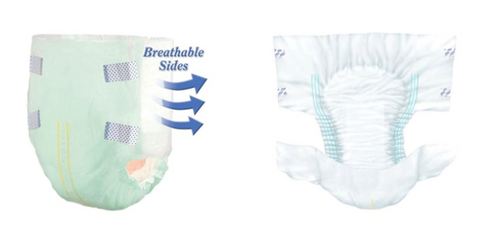
Men's briefs—adult diapers—are yet another option if you are out and about and dread the thought of having to disrobe in a washroom cubicle to change. Although you get great protection for moderate leakage, side tabs make changing quick and easy. It’s important to point out that these briefs do not look like regular underwear so they may not be your choice in the locker room, but they offer a nice, tight fit and are discreet under your clothes.
Tips for Men: How to keep your bladder healthy
Bladder control is not a matter of letting nature run its course. Here are 10 things you can do to help you maintain control of your bladder.
- Maintain a healthy weight — The heavier you are, the more pressure there will be on your bladder.
- Do Kegel exercises (yes, these are for men, too!) — This involves squeezing and relaxing the muscles of the pelvic floor (like holding in a fart).
- Be careful with your medications — Did you know at least 300 different medications can actually cause or worsen incontinence? Talk to your doctor.
- Watch what you drink — Almost any drink with alcohol or caffeine can increase bladder activity and lead to leakage. Don’t drink too much (of course) or too little liquid. Not drinking enough can lead to concentrated urine and constipation; both can irritate the bladder and cause incontinence in men.
- Watch your diet, too — Some foods—such as chocolate (caffeine) and acidic foods such as tomatoes and citrus fruits—can make incontinence worse in some men.
- Don’t smoke — Smoking is bad in so many ways (aside from the obvious). Smoking both increases the risk of men’s bladder cancer over the long term and acts as an immediate bladder irritant. And that can trigger the bladder to dump urine. And that chronic cough associated with smoking? That can cause accidental leakage in men, too.
- Avoid urinary tract infections (UTIs) — UTIs in men can cause temporary incontinence because the bacteria that commonly invade the bladder weaken the muscles in a man’s urethra.
- Weigh the risks and benefits of treatment options — Prostate issues are the source of many bladder-control problems. Since the gland enlarges in almost all men with age, it can have a profound effect on men’s urinary health. Fortunately, there are a variety of treatments for an enlarged prostate. Incontinence is also a common side effect of prostate cancer treatment. However, there are some treatments that are less likely to cause incontinence in men than others, and most patients regain urinary control.
- Avoid constipation — A healthy intake of fibre and fluids can support the neighbouring bladder.
- Limit sugar intake — Although not as well-studied as caffeine and alcohol, some evidence points to the fact that sugary foods, including those with honey, corn syrup and fructose, can also aggravate a man’s bladder. Artificial sweeteners may be no better; some research indicates they contribute to urge incontinence.
You can count on MyLiberty.Life to work with you to provide an array of solutions for your incontinence needs. To understand your options, our Men's guide makes finding and choosing the right product for you fast and easy.
Take control of your life—feel healthier and comfortable again. You deserve it!


